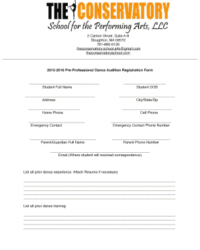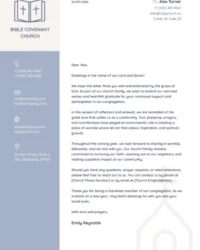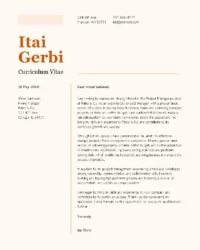Using such a form provides a consistent and organized approach to collecting necessary information about potential cast members. This allows theater programs to efficiently assess candidates, ensuring all relevant details are readily available. For aspiring young actors, it offers a clear and professional way to present their qualifications and express their interest in specific roles. Moreover, a well-designed form can foster a sense of fairness and transparency throughout the casting process.
This article will delve into the essential components of these forms, offering guidance on crafting effective applications and providing examples for various theatrical contexts. Topics covered will include best practices for showcasing a child’s talents, navigating specific requirements, and understanding the overall audition process.
Key Components of a Youth Theater Application Form
Effective applications facilitate a smooth and transparent casting process. Several key elements ensure the collection of essential information while presenting young performers qualifications clearly.
1. Personal Information: This section typically includes the applicant’s full name, date of birth, gender (optional), and contact information (phone number, email address, and mailing address). Accurate contact information is crucial for communication regarding auditions, callbacks, and casting decisions.
2. Guardian/Parent Information: As minors are involved, contact details for a parent or legal guardian are essential. This includes names, phone numbers, and email addresses.
3. Experience: This section allows applicants to list any prior theatrical experience, including roles performed, productions involved in, and the names of the organizations or schools where they participated. Details about training in acting, singing, or dancing should also be included.
4. Special Skills: This section captures unique talents or skills that could be relevant to a production, such as musical instrument proficiency, stage combat experience, dialects, or other special abilities.
5. Availability: Applicants should indicate their availability for rehearsals and performances, including any conflicts or scheduling restrictions. This helps casting directors determine the best fit for each role.
6. Headshot/Photo: A recent photograph of the applicant is generally required. Specific guidelines regarding photo format, size, and style are often provided within the application.
7. Resume/CV (Optional): While not always mandatory for younger applicants, a resume or CV can provide a more comprehensive overview of their experience and training.
8. Performance Video Link (Optional): Some applications request a link to a recent performance video showcasing the applicant’s talent. This allows casting directors to assess performance abilities directly.
A well-structured form streamlines the selection process by providing a standardized framework for gathering and evaluating information, ensuring all necessary details are readily accessible and allowing for informed casting decisions.
How to Create a Youth Theater Application Form
Creating a comprehensive application form is crucial for efficiently managing the influx of potential candidates in youth theater programs. A well-designed form ensures a consistent and organized approach to collecting necessary information, allowing for thorough evaluation and informed casting decisions. The following steps outline the process of developing an effective application form.
1. Determine Required Information: Consider the specific needs of the theater program. Essential information typically includes personal details, contact information for both the applicant and a guardian, prior experience, special skills, and availability. Optional elements, such as headshot/photo uploads or video links, can also be considered.
2. Choose a Format: Select a format that aligns with the program’s resources and technical capabilities. Options include online forms (e.g., Google Forms, JotForm), printable documents (e.g., Word, PDF), or a combination of both. Online forms offer automated data collection and streamlined organization, while printable forms provide accessibility for those without reliable internet access.
3. Structure the Form Logically: Organize the form into clear sections with concise and descriptive headings. A logical flow ensures ease of completion and simplifies the review process.
4. Craft Clear Instructions: Provide specific instructions for each section, clarifying any required formatting or specific details needed. Clear instructions minimize ambiguity and ensure accurate information is provided.
5. Include Consent and Release Statements: Incorporate necessary consent and release statements for minors, ensuring compliance with legal and ethical requirements. These statements should address photo/video usage, medical information release, and participation agreements.
6. Test and Refine: Before launching the form, thoroughly test it to identify any potential issues or areas for improvement. Gather feedback from colleagues or test users to refine the form’s clarity, functionality, and overall effectiveness.
7. Distribute the Form: Make the application form easily accessible to potential applicants through the program’s website, social media channels, or email distribution lists. Clearly communicate application deadlines and any relevant submission instructions.
8. Maintain and Update: Regularly review and update the form as needed, adapting to evolving program requirements and ensuring continued relevance and effectiveness.
By following these steps, theater programs can develop a robust and efficient application process that streamlines candidate evaluation, fosters transparency, and ultimately contributes to successful casting decisions.
Standardized forms for young performers seeking theatrical roles serve as crucial tools, streamlining the application process and ensuring equitable consideration for all candidates. From collecting essential personal and contact information to showcasing experience, skills, and availability, these structured documents facilitate efficient evaluation and informed decision-making by casting directors. A well-designed form benefits both applicants and programs, promoting transparency and professionalism throughout the audition and selection process. The careful consideration of key components, clear instructions, and adherence to legal and ethical guidelines contribute to a robust and effective application system.
Ultimately, investing time and effort in developing comprehensive application procedures cultivates a positive and organized environment for aspiring young artists. This commitment fosters a supportive ecosystem within youth theater, nurturing talent and ensuring a vibrant future for the performing arts.


